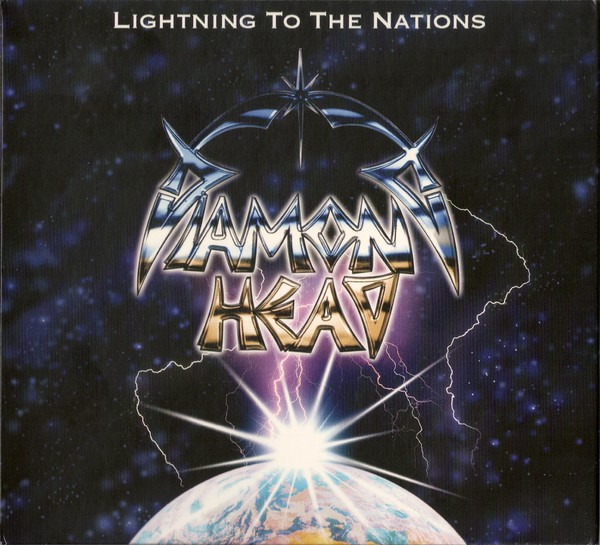Album Review: Lighting to the Nations by Diamond Head

January 7, 2021
Originally released October 3rd, 1980 | Rerecorded and re-released November 20th, 2020
Legendary British heavy metal band Diamond Head recently re-recorded their entire debut album, 1980’s Lighting to the Nations, for its 40th anniversary. Why, you might ask? Well, the original recording sounds… cheap… for lack of a better word; it was recorded cheaply and on such a low budget that the original record came in a blank white sleeve, without even a name. It was never even given a real title, leading to it being referred to by the name of the first song. The album was just a demo paid for by the singer’s mother and sold to their fans for next to nothing. Despite its humble beginnings, and low sales figures, the original 1980 recording has gone on to be one of the most influential albums in heavy metal history. In the years since its release, 5 of the seven songs were covered by Metallica – a band that everyone, regardless of musical taste, has at least heard of, even if they haven’t ever listened to them. Clearly the original version is a great album then, no questions asked. But how does the re-recording compare?
At first, you would think the re-recording would be better: after all, the band has had 40 years to improve their skills. But it’s not the same band. For all intents and purposes the Diamond Head of today is simply a cover band that happens to have one original member. In all fairness, that one member, guitarist Brian Tatler, did co-write all of the songs, but original singer Sean Harris also co-wrote.
The 2020 re-recording, despite its superior sound quality, has the unfortunate side effect of sounding like everything else being released today. While the original was ahead of the curve in 1980, by 2020 everything on it has been done time and time again. It doesn’t sound like Diamond Head; it sounds like someone trying to be Diamond Head. The lyrics suffer from a bad case of “cool in the 80s” and come with heavy metal cliches that had been discarded due to sheer ridiculousness by the 90s. To put it bluntly, some of these songs have not aged well, and the members’ aging hasn’t helped. A nineteen-year-old singing a song called “Sweet and Innocent” is somewhat acceptable, but at 60, just comes off as creepy.
Speaking of the vocals, the ones on the re-recording are more than a little boring. The original singer, Sean Harris, had a distinctive voice that fit the songs well. While the new singer might be technically superior, he lacks any real personality. The guitar tone used on the re-recording is more distorted and more powerful than the original, but as the techniques and style of the guitarist are straight out of the 1980s, it just feels wrong and out of place. The bass is more distorted but has a slightly “fizzy” tone that’s, again, not “bad”, but feels out of place on a traditional metal album.
The drums on the new version are somewhat lacking in a few respects: they are pushed somewhat to the back of the mix, and the kick drum suffers from the unfortunate click that is far too prevalent in modern metal. Additionally, the original album uses one kick drum, while the new version uses double kick drums (one played with each foot), something that was still a few years off from being the standard in metal music, but is now inescapable. I was obviously not there in the studio, so I can’t know for sure, but it’s highly likely some of the drums were augmented with samples. More importantly, the new drummer plays like a modern drummer, and lacks some of the groove and swing more common in an older drummer. Again, this isn’t necessarily a bad thing; it just doesn’t suit the music quite as well.
While the new version probably had all of the instruments recorded separately to a click track, the original was recorded essentially live in the studio, and as such has a certain “vibe” or “feeling” that’s hard to put into words. The rerecording has been edited and tweaked to be “perfect”, and comes off as a little lifeless and cold. This album is not necessarily bad, but it just doesn’t need to exist. I can understand being unhappy with old work, and yes, the recording of the original was cheap and done quickly, and no one was expected to hear it – but people did, and they liked it as it was.
The biggest problem with the re-recording is that the songs on it were written by teenagers; the band members were only about 19 at the time they wrote and recorded it, and it shows in places. There’s a huge difference between writing and playing a song at 20 and at 60. It’s one thing to play an old song, but it’s another to try and relive your glory years by remaking the song that made you “famous”. The album makes a ton of performance and production decisions that aren’t bad, but don’t serve the songs as well as they could. If this was a new album by a new band, I might like it better, but the strongest emotion this excites in me is just… confusion. I don’t really understand why it exists, because it certainly didn’t need to.
In the end, should you listen to this rerecording? In my opinion, no. If you want to experience these songs, just listen to the (flawed) original. Even lacking refinement, it is far superior in many respects. I listened to the remake for this review, but I doubt I ever will again.